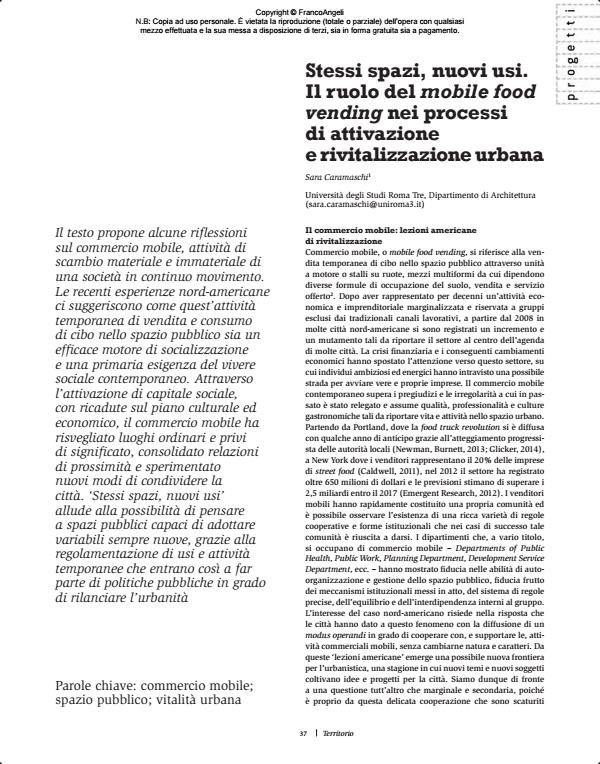Stessi spazi, nuovi usi. Il ruolo del mobile food vending nei processi di attivazione e rivitalizzazione urbana
Journal title TERRITORIO
Author/s Sara Caramaschi
Publishing Year 2017 Issue 2016/79
Language Italian Pages 6 P. 37-42 File size 375 KB
DOI 10.3280/TR2016-079006
DOI is like a bar code for intellectual property: to have more infomation
click here
Below, you can see the article first page
If you want to buy this article in PDF format, you can do it, following the instructions to buy download credits

FrancoAngeli is member of Publishers International Linking Association, Inc (PILA), a not-for-profit association which run the CrossRef service enabling links to and from online scholarly content.
Il testo propone alcune riflessioni sul commercio mobile, attività di scambio materiale e immateriale di una società in continuo movimento. Le recenti esperienze nord-americane ci suggeriscono come quest’attività temporanea di vendita e consumo di cibo nello spazio pubblico sia un efficace motore di socializzazione e una primaria esigenza del vivere sociale contemporaneo. Attraverso l’attivazione di capitale sociale, con ricadute sul piano culturale ed economico, il commercio mobile ha risvegliato luoghi ordinari e privi di significato, consolidato relazioni di prossimità e sperimentato nuovi modi di condividere la città. ‘Stessi spazi, nuovi usi’ allude alla possibilità di pensare a spazi pubblici capaci di adottare variabili sempre nuove, grazie alla regolamentazione di usi e attività temporanee che entrano così a far parte di politiche pubbliche in grado di rilanciare l’urbanità
Keywords: Commercio mobile; spazio pubblico; vitalità urbana
- Computational Science and Its Applications – ICCSA 2024 Workshops Silvia Battino, Salvatore Lampreu, Brisol García García, pp.18 (ISBN:978-3-031-65331-5)
Sara Caramaschi, Stessi spazi, nuovi usi. Il ruolo del mobile food vending nei processi di attivazione e rivitalizzazione urbana in "TERRITORIO" 79/2016, pp 37-42, DOI: 10.3280/TR2016-079006